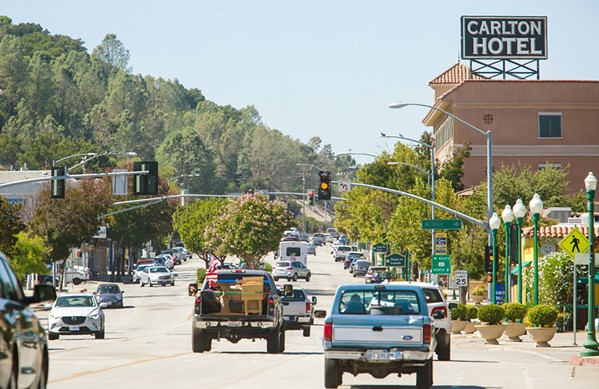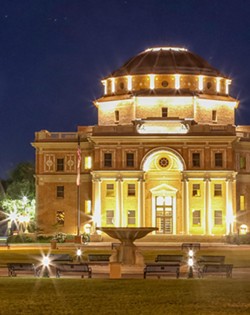Atascadero evolution: The city's downtown is getting a facelift this summer, while staff work on a vision for Atascadero's future
By Camillia Lanham[{
"name": "Ad - Medium Rectangle CC01 - 300x250",
"id": "AdMediumRectangleCC01300x250",
"class": "inlineCenter",
"insertPoint": "8",
"component": "2963441",
"requiredCountToDisplay": "12"
},{
"name": "Ad - Medium Rectangle LC01 - 300x250",
"id": "AdMediumRectangleCC01300x250",
"class": "inlineCenter",
"insertPoint": "18",
"component": "2963441",
"requiredCountToDisplay": "22"
},{
"name": "Ad - Medium Rectangle LC09 - 300x250",
"id": "AdMediumRectangleLC09300x250",
"class": "inlineCenter",
"insertPoint": "28",
"component": "3252660",
"requiredCountToDisplay": "32"
}]
With the Salinas River marking the city's eastern boundary and the Santa Lucia Range to the west, Atascadero can't really grow outward.
Couple that with emergency access, wildfire risk, and sewer service capabilities, and the options narrow even further.
"We have to go inward. We don't have a lot of buildable land," Community Development Director Phil Dunsmore told the Atascadero City Council on March 26. "We don't have the land that a lot of our surrounding areas do, ... raw, vacant, open land."
The hills and dales to the west of town make growth difficult, as they can't be serviced by the city sewer system, which is gravity fed; the rural, curvy roads make it difficult for emergency services to access; and the wildfire risk is high. Dunsmore told New Times that properties in the more rural hills are on septic systems, which are regulated by the State Water Resources Control Board and limited to a certain number of residential units per acre. So, it would be a difficult place to increase housing density.
But the city does have plans to grow while maintaining its rural, small-town feel. It's solidifying that vision for the future—a vibrant downtown; safer, more walkable neighborhoods; and a better jobs/housing balance—with the "big moves" that are driving an update to the city's general plan, which will take Atascadero through 2045.
Guided by the City Council and the concept of placemaking along El Camino Real, which runs from one end of town to the other, these moves include creating a mix of housing types; attracting new industries and higher wage jobs; improving mobility, access, and safety; addressing public infrastructure needs; and ensuring fiscal sustainability.
"Atascadero's been plagued with classic urban sprawl. ... We have literally 6 or 7 miles of just urban development, and it feels scattered," Dunsmore told New Times. "Placemaking is the idea of creating places where people what to be. ... Placemaking is not a fast-moving road or a parking lot."
El Camino has always been a part of Atascadero, running along a commercial area downtown next to the creek with a residential community surrounding it. But when Highway 101 was built in the 1950s, the character and layout of what was then county land changed significantly. The freeway that runs parallel to El Camino bisected Atascadero, and commercial areas popped up along the exits.
"We're forever trying to recover from that," Dunsmore said. "But we've come a long way."
In the last five years, the city's long-planned downtown revitalization took a major step forward between Traffic Way and Sunken Gardens along El Camino. In addition to bringing major annual events like the Tamale Festival and the Winter Carnival to Sunken Gardens, restaurant and retail spaces have multiplied along the eastern flank of El Camino. The Colony Market & Deli took over the abandoned gas station on the corner of Traffic Way and El Camino; Ancient Owl Beer Garden opened next door; and the La Plaza mixed-use project brought more residential, restaurant, and retail space to the area.
With retail shops, breweries, distilleries, and fine dining establishments such as Cielo and Barley and Boar, city Director of Community Services and Promotions Terrie Banish said downtown has really become a place where locals can spend their time eating, shopping, and drinking.
"Atascadero is becoming kind of its own destination for tourism; people want that local vibe, they want that local feel," Banish said. "It's an exciting time to be a part of the city."
That walkability and vibrance is something Atascadero will continue to build along Sunken Gardens and El Camino. Dunsmore said that medical and business offices are slowly relocating from along the park to make room for more retail and restaurants. This summer, the city will realize a major part of the Downtown Infrastructure Enhancement Plan by starting construction along about three blocks of El Camino through downtown.The main thoroughfare will be reduced from five lanes to one lane in each direction with a center lane for parking through about three blocks of downtown. Dunsmore said he's hoping the project goes out to bid in late April or early May and starts construction by June or July.
While the general plan update won't call for making any major changes to what's already going on downtown, Atascadero wants to encourage infill on a strip of land north of downtown as a way to continue building vibrancy in the city's core. This would include making space for taller buildings, more density, and mixed-use development.
"Our downtown today is headed in a really great direction. We want to continue to support that," Dunsmore said during the March 26 City Council meeting.
Downtown will remain the city's core, but, Dunsmore said, through this concept of placemaking, the general plan update aims to make way for other, smaller cores along El Camino.
To determine where, city staff took input from city residents last year through a series of pop-ups and open houses and an online survey. Property owners were also able to propose specific changes for the kind of development they wanted to see on their land. While staff wasn't able to accommodate everyone, Dunsmore said they incorporated feedback the best they could.
By focusing on 11 key areas throughout the city, the general plan update aims to increase the number of jobs in the city, create space for infill housing, and plan for population growth of about 1 percent per year. A city consultant called the update a realistic forecast for new uses, commercial spaces, and infrastructure that aims to produce "aggressive job growth for the city."
"We're not saying we're going to grow to this," Mayor Heather Moreno said. "We're saying we're going to put policies in place that are going to make space for this."
One of the big ideas is to encourage development of commercial areas that could provide jobs, shopping, and dining to residential neighborhoods that surround them. Some key areas along El Camino include Del Rio Road, San Anselmo, and Santa Rosa Road. The plan would increase housing density in these areas, reduce commutes for city residents, produce more revenue for Atascadero, and create more welcoming spaces for locals to spend time and money.
However, the update is still in the planning phase. Dunsmore encouraged the City Council to consider the March 26 presentation a "check-in," with more conversations to come in the future, including an environmental impact analysis and an economic analysis the city hopes to begin this summer. Δ
Reach Editor Camillia Lanham at [email protected].
Latest in News
Readers also liked…
-

Coast Unified teachers upset over new position's salary and qualifications
Oct 20, 2022 -

SLO police identify alleged driver who hit and killed couple
Dec 22, 2022 -

When the levee breaks: Oceano residents, county officials walk a tightrope of regulations to manage Arroyo Grande Creek, which some say led to the levee's failure in January
May 18, 2023











